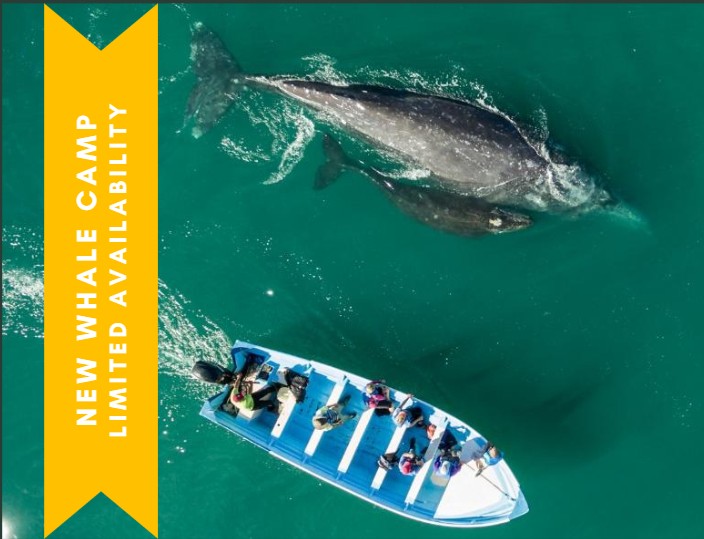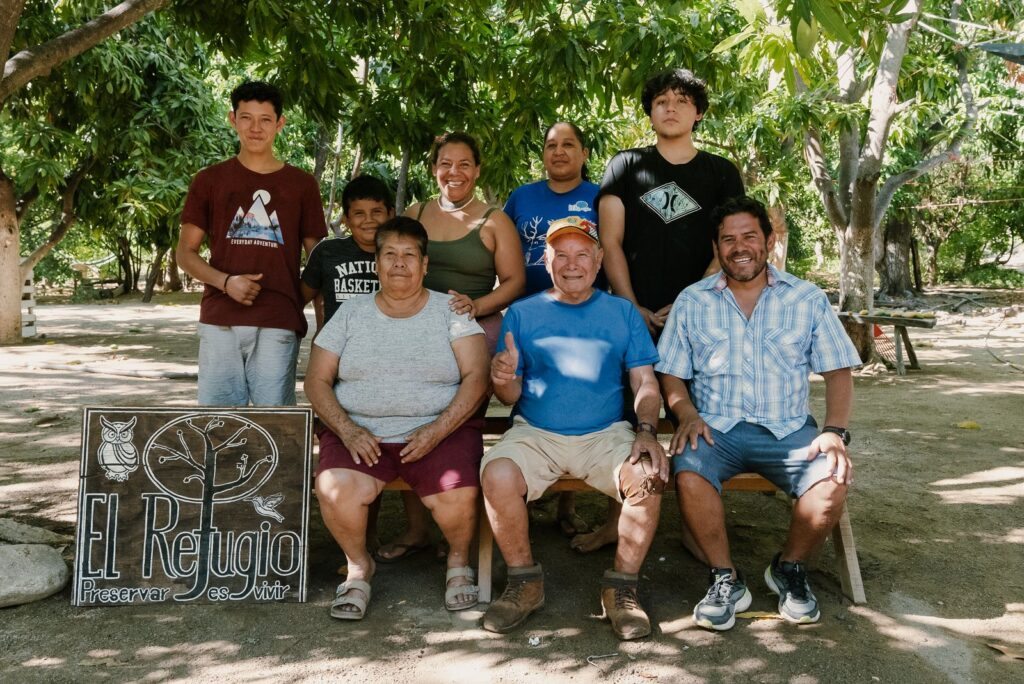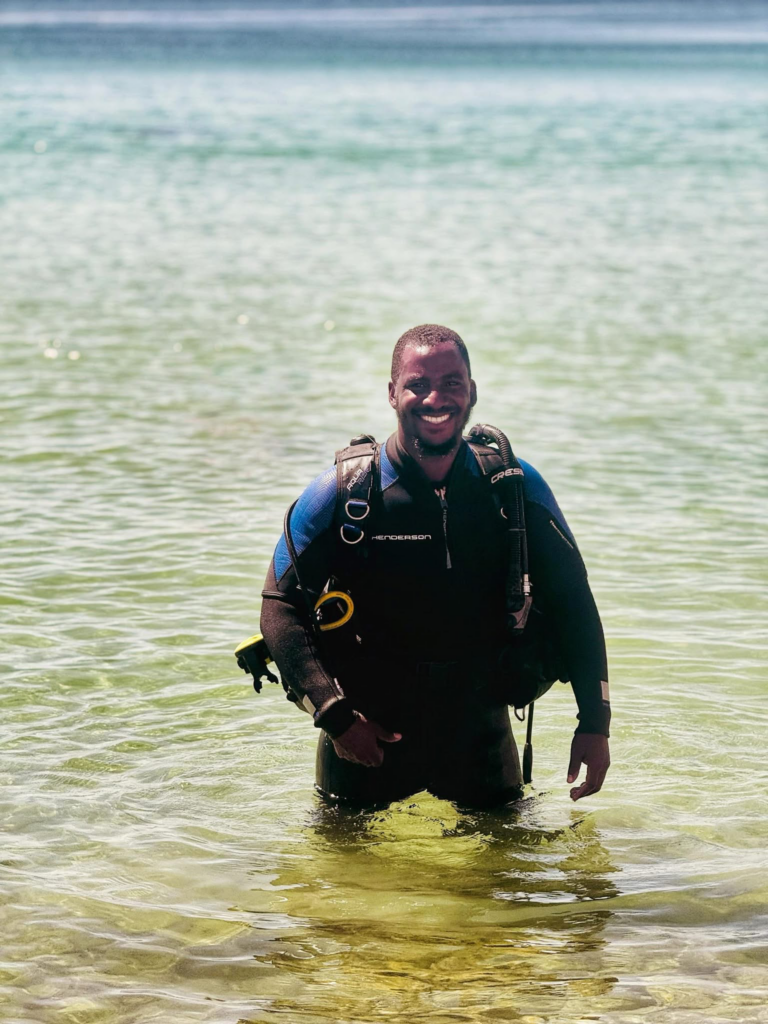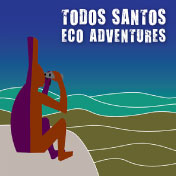
by Bryan Jáuregui | Wildlife Encounters
Camp Cecil de la Bahia Whale Watching
A stand-out highlight of any trip to Baja!
Welcome to Magdalena Bay and our luxury tent camp Camp Cecil de la Bahia! The camp is located on a sliver of land with the Bay and the gray whales on one side, and a protected estuary with mangroves, abundant birdlife, dolphins and more on the other. Each year the gray whales migrate 6,000 miles from arctic waters to the Pacific lagoons of the Baja peninsula to mate, give birth, and enjoy a warm winter respite. Magdalena Bay is one of the most important of these lagoons, and Camp Cecil de la Bahia is one of the best whale watching spots in all of Baja. Whales are simply everywhere!
The tents of Camp Cecil de la Bahia are beautifully appointed walk-in safari-style tents with gorgeous beds, seating areas, rugs, chandeliers, and ensuite bathrooms. The camp chef prepares three beautiful meals a day and daily happy hour.
We’ll spend the days out on the water interacting with the amazing gray whale mothers, babies and sporting males, and when not with the whales we can explore the incredible birdlife of the mangrove estuary. It is a dreamy, wild and remote spot, completely ensconced in nature, enhanced by delights of great food and comfortable lodging.
PLEASE NOTE LIMITED AVAILABILITY DURING THE GRAY WHALE SEASON JANUARY 25 – MARCH 15 EACH YEAR
Price Includes
- Transportation to/from Todos Santos or La Paz
- Accommodation for 3 nights in a luxury tent with real beds, lovely linens, rugs, chandeliers and ensuite toilets
- Beautiful, chef-prepared meals from welcome lunch on Day 1 through lunch on final day
- Daily happy hour and drinks with dinner
- Twice daily whale watching excursions, fishing, birding and mangrove exploration
- Bilingual naturalist guide(s) who is a certified Wilderness First Responder, NOM-9 Graduate and Leave No Trace certified
- Entrance fee and permits
Excludes:
- International airfare
- Gratuities
- Travel insurance
- Any activities, meals or drinks not explicitly identified in the itinerary
Note: This adventure is available from January 25 – March 15 yearly
Dates
- Jan 25-28: 4 tents left
- Feb 1-4: 4 tents left
- Feb 5-8: 3 tents left
- Feb 8-11: Sold Out
- Feb 11-14: Sold Out
- Feb 16-19: Sold Out
- Feb 23-26: 2 tents left
- Feb 26-March 9: Sold out
- March 9-12: 4 tents left
- March 12-15: Sold Out
Price USD
- Please enquire for pricing
- A 16% IVA tax will be added to all prices
Price MXN
- Please enquire for pricing
- A 16% IVA tax will be added to all prices

by Sonya Bradley | Blog

Photo by Ernesto Lopez
Don Cata and the Wild Bulls of Baja
by Bryan Jáuregui
Lidia bulls are running wild in the mountains of Baja California Sur – at least those who can outrun Don Catarino Rosas Espinosa. Lidia bulls, also known as Spanish Fighting Bulls, are a distinctive breed of cattle from the Iberian Peninsula that are known for their aggressiveness, strength and stamina. They have nothing on Don Cata.
The Lidia bulls burst onto the Sierra La Laguna fauna scene in 1986 when a Miraflores rancher named Collins grew older and moved away, freeing his milk cows and bulls of different breeds to roam, including the Lidia bulls. In 1989 Don Cata, then 36 years old, struck a deal with the Collins descendants to round up as many of the bulls as possible in exchange for 35% of the proceeds when they were sold. His bull hunting career was launched.
“I hunted the bulls from my 30s through my 50s” recalls Don Cata, who still hunts feral pigs today at the age of 72. “Most of the bulls we encountered over the years were totally wild and had never seen humans before.” Don Cata had a remarkable methodology for hunting the bulls. “I always had two dogs, a Pitbull and a German Shepherd. I would look for the footprint of the bull, then send the dogs to run after it. I would run right behind them on foot as there was no way that horses or mules could navigate that terrain. Usually after the first 6 or 7 kilometers the dogs and I would catch up with the bull then he would run again. Usually after the third run – which sometimes meant a total 15 kilometers of terrain covered – the bull would finally tire and lean against a tree.”
Don Cata not only ran after the bull and the dogs, but did so while wearing two lengths of rope across his chest (“I looked like Pancho Villa”) and one around his waist. Once the bull finally tired and was resting against a tree, Don Cata would lasso its horns and tie its head to the tree with one rope, then use another rope to lasso a hind leg and tie it to another tree such that the rope would tighten when the bull struggled. He would then use the third rope to lasso the bull’s front legs. That third lasso would bring the bull down and Don Cata would then tie up the final hind leg. So far so good.
But Don Cata, who is all of 72 kilograms / 158 pounds, now has a seriously angry, 600 kilo / 1,300 pound animal – whose breed is notorious for its aggressiveness – tied up in rugged mountain terrain while traveling on foot. He only gets paid when he delivers the bull alive several thousand feet below. Sheer physicality, stamina and mad cowboy skills have gotten him this far. Now it’s time to out psych the bull. “The bulls were so angry that they usually needed about 90 minutes to calm down” recalls Don Cata, “so the dogs and I would wait downwind while they quieted. Then I would go back, release one of the legs and tie a stick to the foreleg such that it stopped the bull from running. I would then leave again and let the bull get used to the stick. Then the next time the bull saw me he would be very tired and very afraid of me, so I could release all the ropes. If he lunged for me I could parry him away with a stick that I used like a lance. In this way I could get a bull down the mountain in 2-3 days.”
 Don Cata created a type of corral where he would collect 18 to 20 bulls, put bells on them, then get them to the road where a truck would pick them up, weigh them and deliver them to the Collins family. “I got over 600 bulls like this” recalls Dona Cata. In a masterful piece of understatement about his running skills Don Cata notes, “I was fast.”
Don Cata created a type of corral where he would collect 18 to 20 bulls, put bells on them, then get them to the road where a truck would pick them up, weigh them and deliver them to the Collins family. “I got over 600 bulls like this” recalls Dona Cata. In a masterful piece of understatement about his running skills Don Cata notes, “I was fast.”
The bulls scored some points as well. “Once I was tying a bull’s head to a tree and trying to do it quickly because the bull had already closed its eyes in anticipation of hitting me. I was moving fast and slipped. My rope was round the bull’s head so when I went down the whole 600 kilo body of the bull came down on top of me. It really messed up my knee.” A local rancher patched him up and suggested he put his bull hunting days behind him. “I didn’t listen. 3 days later I was running after the bulls again.” (His knee remains a little wonky looking to this day.) And one bull did succeed in head-butting him. Luckily the horn just grazed his skull but the force caused the fur of the bull’s head to burn his ear.
As he moved into his 50s Don Cata took on another feral animal – pigs. “When I was a child ranchers used to raise a lot of pigs, not to sell, just to eat. When the hurricanes hit the pigs would head to the hills to eat all the acorns, pine nuts etc that had been blown off the trees, then head back home.”
 Then in 1997 a major hurricane hit off the coast of Los Cabos and it rained for 3 days straight. This created an enormous bounty of food and water for the pigs so in the ensuing years their population exploded. “There were so many pigs that they were eating all the grass in the valley of the mountain and really damaging the ecosystem” recalls Don Cata. The Sierra La Laguna Biosphere Reserve park authorities decided that some of the pigs needed to be eradicated so they contracted Don Cata for the job. “Thankfully the pigs prefer terrain that is accessible by horse and mule” the older Don Cata laughingly notes.
Then in 1997 a major hurricane hit off the coast of Los Cabos and it rained for 3 days straight. This created an enormous bounty of food and water for the pigs so in the ensuing years their population exploded. “There were so many pigs that they were eating all the grass in the valley of the mountain and really damaging the ecosystem” recalls Don Cata. The Sierra La Laguna Biosphere Reserve park authorities decided that some of the pigs needed to be eradicated so they contracted Don Cata for the job. “Thankfully the pigs prefer terrain that is accessible by horse and mule” the older Don Cata laughingly notes.
While pig hunting requires less stamina than bull hunting, it is infinitely more dangerous. The pigs have long, sharp tusks and are extremely strong. To catch them, Don Cata sends his dog to track a pig and grab it by the ear. Don Cata then gets off his horse, picks the pig up by its hind leg, and shoots it. While many ranchers use knives for the kill, Don Cata hunts with CIBNOR, the Centro de Investigaciones Biológicas del Noroeste S.C., and they want to weigh and measure the pigs without the blood loss that accompanies a knife wound. CIBNOR takes samples of each pig’s organs to make sure the pig is healthy enough to be eaten. Says Don Cata, “I usually hunt for 4 days and come down with 80 to 100 kilos of meat to sell.” Don Cata reckons he’s caught over 1,000 pigs.
Pig hunting is intimate business and Don Cata has far more scars from pigs than bulls. It is therefore perhaps not surprising to learn that while Don Cata is famous for his hunting skills, he is legendary for his healing skills, and people come from all across the state to seek his help.
Don Cata is the patriarch of the Rosas family and preserving the ranchero way of life is a key family goal at their beautiful Rancho Ecológico el Refugio in the Sierra mountains. Don Cata himself embodies the ranchero ideal, with both the strength and skill to confront wild forces and the wisdom and talent to restore health and balance in his community. He manifests a profound connection with nature. He is a hunter-healer.

The Family at El Refugio / Photo by Mike Brinkman

by Sonya Bradley | Blog
The Mission is Simple: Empower Guides, foster cross-cultural conservation practices, and celebrate world ecosystems.
Todos Santos Eco Adventures is a proud member of the Kusini Collection, a hand-picked portfolio of sustainable, owner/founder-operated camps, lodges and tour operators in Africa, Asia and the Americas. Some years ago we presented the idea of a guide exchange program with the other members. We’re extremely thrilled to share that it is a complete success and continues to grow and enrich the lives of not only our guides but all of us! A recent exchange just took place with Ultimate Safaris from Namibia and they have shared the following.
“As a leader in conservation-based luxury travel in Namibia, we have once again demonstrated our commitment to people and the planet with our third consecutive international guide exchange, investing over N$ 300,000 into the initiative since its inception.
 This year, Jason Nengola, Ultimate Safaris’ 2024 Ultimate Guide of the Year, travelled to Baja California, Mexico, for a three-week immersion experience with Todos Santos Eco Adventures. The exchange underscores a shared mission between the two companies: to empower guides, foster cross-cultural conservation practices, and celebrate the ecosystems they passionately protect.
This year, Jason Nengola, Ultimate Safaris’ 2024 Ultimate Guide of the Year, travelled to Baja California, Mexico, for a three-week immersion experience with Todos Santos Eco Adventures. The exchange underscores a shared mission between the two companies: to empower guides, foster cross-cultural conservation practices, and celebrate the ecosystems they passionately protect.
“The guide swap initiative is a great opportunity for interaction and learning between people on different sides of the world who may have differing geographies, wildlife, and weather—but who share the same dedication to conservation and community,” said Tristan Cowley, Co-founder and Managing Director of Ultimate Safaris.
Jason’s journey from Namibia’s vast deserts to Mexico’s vibrant marine ecosystems was nothing short of transformative. From snorkeling and scuba diving to whale watching and leather-making from cactus, Jason embraced new perspectives—both professionally and personally.
“Imagine Damaraland with an ocean,” Jason remarked. “Being a guest, not a guide, helped me understand how our guests must feel. It was a humbling and eye-opening experience.”
He encountered four species of whales—Blue, Humpback, Fin, and Grey—an awe-inspiring highlight that shifted his perspective on control, nature, and the role of a guide. In addition to nature-based activities, the exchange allowed Jason to explore Mexico’s strong connection to its local culture and cuisine—an experience that left a lasting impression.
“In Namibia, we have so many rich cultures and traditions to share,” he said. “The food in Mexico inspired me to think about how we can better incorporate Namibian cuisine into our guest experiences.”
Jason also reconnected with Axel Herrera, a Todos Santos guide who had previously visited Namibia through the same exchange program—reinforcing the mutual value and long-term relationships fostered by this initiative.
Later this year, a Mexican guide will travel to Namibia for the next chapter of this growing partnership, continuing the spirit of knowledge-sharing, cultural appreciation, and environmental stewardship.
The Ultimate Safaris and Todos Santos Eco Adventures guide exchange initiative represents a model for global collaboration in eco-tourism—building not only better guides, but stronger bridges between continents, cultures, and conservation efforts.”

by Sonya Bradley | Blog
A Holistic Approach to Sustainability in Mexico
Recently REMOTE LA placed a spotlight on the efforts of select partners, who are demonstrating that Latin America and the Caribbean are not just embracing sustainable and regenerative tourism—they are shaping a resilient future. Through carbon offset and capture programs, conservation initiatives, responsible business practices and bold climate action plans, these companies are proving that tourism can—and must—be a force for good. Their work reassures us that conscious international travelers can continue to visit Latin America while actively contributing to the well-being of its destinations.
We proudly share what they had to say about us:
Todos Santos Eco Adventures (TOSEA) is at the forefront of responsible tourism in Baja California Sur, Mexico, integrating sustainability into every aspect of its operations. As a member of the Global Sustainable Tourism Council (GSTC) and a signatory of the Future of Tourism Coalition, TOSEA spearheads initiatives that drive conservation and sustainability in the region. One of its most ambitious projects is supporting the Alianza Cero Basura, which works to establish Mexico’s first Zero Waste destination in Todos Santos and El Pescadero, setting a groundbreaking precedent for responsible tourism.
TOSEA is also taking decisive action against climate change through its partnership with Tomorrow’s Air, significantly increasing its contributions to carbon capture, having successfully removed and stored three tons of CO₂ so far. Their holistic approach to sustainability extends beyond waste reduction and emissions mitigation. TOSEA is deeply involved in conservation efforts and embedding regenerative principles into its tourism model, demonstrating that sustainability is not just about minimizing harm; it’s about fostering a thriving future for both local communities and the environment.
















 Don Cata created a type of corral where he would collect 18 to 20 bulls, put bells on them, then get them to the road where a truck would pick them up, weigh them and deliver them to the Collins family. “I got over 600 bulls like this” recalls Dona Cata. In a masterful piece of understatement about his running skills Don Cata notes, “I was fast.”
Don Cata created a type of corral where he would collect 18 to 20 bulls, put bells on them, then get them to the road where a truck would pick them up, weigh them and deliver them to the Collins family. “I got over 600 bulls like this” recalls Dona Cata. In a masterful piece of understatement about his running skills Don Cata notes, “I was fast.” Then in 1997 a major hurricane hit off the coast of Los Cabos and it rained for 3 days straight. This created an enormous bounty of food and water for the pigs so in the ensuing years their population exploded. “There were so many pigs that they were eating all the grass in the valley of the mountain and really damaging the ecosystem” recalls Don Cata. The Sierra La Laguna Biosphere Reserve park authorities decided that some of the pigs needed to be eradicated so they contracted Don Cata for the job. “Thankfully the pigs prefer terrain that is accessible by horse and mule” the older Don Cata laughingly notes.
Then in 1997 a major hurricane hit off the coast of Los Cabos and it rained for 3 days straight. This created an enormous bounty of food and water for the pigs so in the ensuing years their population exploded. “There were so many pigs that they were eating all the grass in the valley of the mountain and really damaging the ecosystem” recalls Don Cata. The Sierra La Laguna Biosphere Reserve park authorities decided that some of the pigs needed to be eradicated so they contracted Don Cata for the job. “Thankfully the pigs prefer terrain that is accessible by horse and mule” the older Don Cata laughingly notes.

 This year, Jason Nengola, Ultimate Safaris’ 2024 Ultimate Guide of the Year, travelled to Baja California, Mexico, for a three-week immersion experience with Todos Santos Eco Adventures. The exchange underscores a shared mission between the two companies: to empower guides, foster cross-cultural conservation practices, and celebrate the ecosystems they passionately protect.
This year, Jason Nengola, Ultimate Safaris’ 2024 Ultimate Guide of the Year, travelled to Baja California, Mexico, for a three-week immersion experience with Todos Santos Eco Adventures. The exchange underscores a shared mission between the two companies: to empower guides, foster cross-cultural conservation practices, and celebrate the ecosystems they passionately protect.
